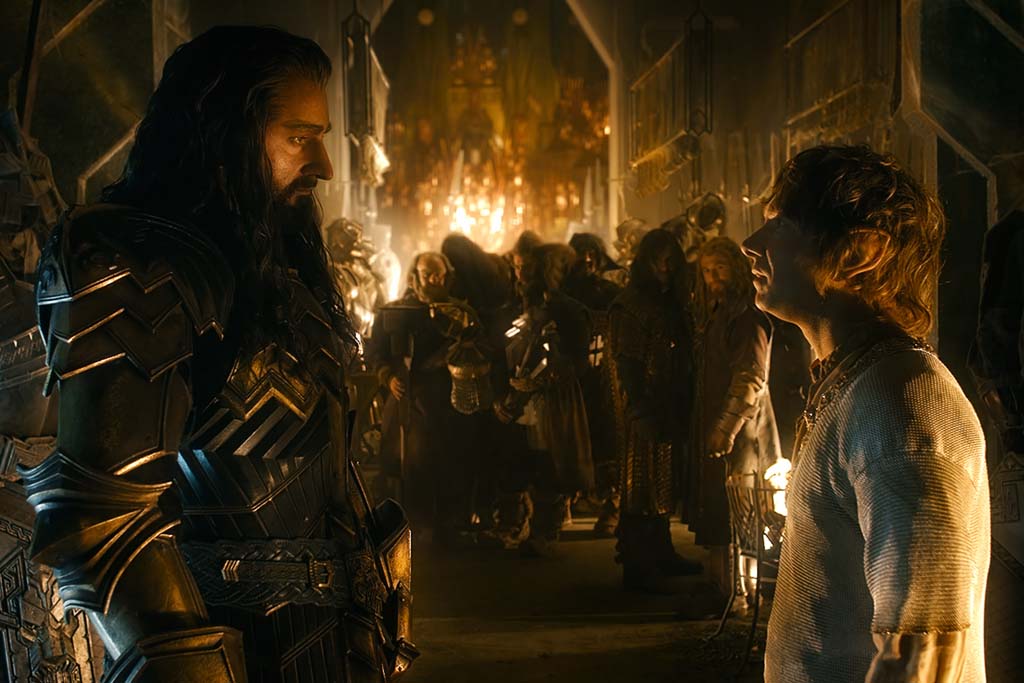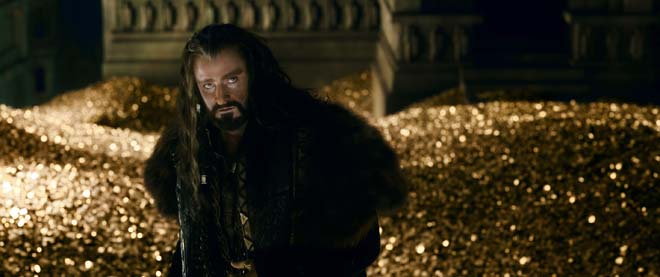Peter Jackson’s Final Hobbit Film Is A Battle To Stay Awake
An unexpected journey into boredom.

Peter Jackson’s return to Middle Earth after the world-beating, bank-busting, and award-harvesting success of the Lord of the Rings trilogy ought to have felt like the return of a conquering hero. Instead, his new trilogy, based on The Hobbit, has been a tired, bloated slog.
Jackson had been unwilling to take the reigns on the Hobbit films from the very start, passing off directorial duties to horror maestro Guillermo del Toro, until interminable scheduling delays caused him to leave the project. When Jackson finally agreed to take the helm, it seemed to be with an air of reluctance, although he has claimed he soon found himself excited by the material.
Nevertheless, the new trilogy has been a strange combination of over-stuffed and under-cooked: a grand saga conjured out of the slightest book; a mass of subplots and CGI spectacle designed to recapture the fun of the Rings trilogy, but without the sense of energy and purpose that made those films work. It seems weird to call a 474-minute, $745 million film saga “perfunctory”, but that’s what’s up. We’re through the looking glass here, people.
At 144 minutes, the latest entry—The Battle of the Five Armies—is the shortest of the trilogy, but it still feels overly busy. When word passed down that the Hobbit series was going to be extended from a projected duology into a trilogy, the rumour travelled that Jackson and co. would make use of Tolkien’s various appendices to The Lord of the Rings, to spin out new narrative material to cover the gap between The Hobbit and The Fellowship of the Ring. Whether of not any of that was filmed, it’s not present in the new film, which presents only an expanded version of the final section of Tolkien’s original novel, stretched out to indigestible proportions.
A Battle Of Endurance
The films picks up at the very second the previous entry—The Desolation of Smaug—left off: the adventuring dwarves have successfully banished the dragon Smaug from their mountain kingdom of Erebor, and they look on with mixed feelings as the beast wings his way over the lake to put the defenseless community of Laketown to the torch. After a brief (though brief is relative in this trilogy) tying up of loose ends, the film sets about living up to its title.
The dwarf king Thorin (Richard Armitage), now master of his domain, comes down with a bad case of the ludicrously titled ‘dragon sickness’. He jealously refuses to part with any of his newly acquired treasure, even to honor existing agreements with the Laketown citizens—led by macho archer Bard (Luke Evans)—or to return lost treasure to the elves of Mirkwood—led by haughty king Thranduil (Lee Pace)—and generally goes about insulting and alienating his dwarf buddies. Various armies amass (guess how many) to lay siege to Erebor, or to fight off the besiegers, or to fight off the army besieging the besiegers, and so on. Bilbo (Martin Freeman) wanders around, basically making time until the narrative can dump him back into the Shire.
Jackson, and co-writers Fran Walsh and Phillipa Boyens (del Toro is also credited) have invented a series of subplots to give this film a coherent narrative spine, including a half-hearted romance between one of Thorin’s dwarves and an elf-princess, and a general expansion of the various motives behind the titular battle — but they seem to have confused ‘antics’ with ‘storytelling’. Although these strands are competently plotted, they are dull as dishwater, dragged down by lugubrious dramatics, insufferable, cod-Ye Olde dialogue, unnecessary spectacle, and a basic disinterest in normal human behaviour.
Spoiler, I guess: Thorin snaps out of his dragon sickness when he wanders off through Erebor alone and hallucinates himself sinking into a floor made of molten gold. Thus returned to sanity, he ambles back to his dwarven kin, neglects to apologise for his madness, and hustles them all into the deadly battle raging outside. That’s right; Jackson, Walsh and Boyens would prefer to have their hero onanistically find his true self in a big old heap of money than stage a meaningful dramatic interaction between characters. There’s a metaphor there.
The Desolation Of Acting
Of the cast, Lee Pace makes off the best, if only because Thranduil is such a dick. He manages to pull off the only unforced moment of humour in perhaps the entire trilogy when he surreptitiously starts rolling his eyes at one of Gandalf’s haranguing speeches.
Although he remains perfectly cast as Bilbo, Martin Freeman comes off the worst, in part because the film gives him a large narrative load with very little character work to support it. His job seems to be to run around and involve himself in the various antics, all the while projecting a sort of free-floating ideal of ‘decency’. In the absence of any part of real substance to play, Freeman drives most of his acting to his face, restricting himself to a flimsy bag of tricks: a recurring twist of the nose, and a sort of combination sigh-and-slump.
This contraction of the actors’ responsibility seems to be de rigueur for Jackson’s technique now. It seems clear that he does not really require from his performers any sort of acting, in a qualitative or quantitative sense, but rather a very specialised sort of modeling: stand here; emote this; emote that; look at the imaginary beast; hit your mark.
With the exception of a few, well-crafted moments, the cast doesn’t seem to be performing dramatic situations—in the traditional sense—but rather offering a fragmented set of mechanical responses that can later be digitally incorporated into fully rendered scenes. Billy Connelly turns up for a cameo as another dwarf lord, and cousin to Thorin, but I could swear that for 90% of his screen time he is completely CGI.
It’s All Just Too Much
Like its two predecessors, The Battle of the Five Armies has been made (but not always screened) in a high frame rate format. If you get the chance to see it this way, I recommend it, but mostly because it’s so goddam strange. Films have historically been shot and exhibited at a rate of 24 frames per second, and that has stayed pretty much consistent even as actual, physical film has been phased out by digital technologies. 24 fps just looks right, to the lay audience.
The look of higher frame rates is more associated with video technologies – if you remember thinking that your home-filmed DVs or VHS look weird in comparison to proper movies, a lot of that has to do with frame rates. Jackson’s rationale behind shooting his films this way seems to be that the technology is coming—pretty much whether we like it or not—and theatrical movies have to start innovating if they’re going to survive.
But the consequence of having essentially double the amount of visual information on screen at any given second is oddly disorienting. The image ought to be crisper, but it somehow looks muddier. Lighting gets confused. Hair, make-up, and sets look completely unreal, as though the surge in data quantity has exposed their falsity.
But if we think of the HFR Hobbit films as the authentic versions, their oddities become a symbol for the problems of the entire series. Jackson’s new trilogy is a sad case of cinema bogged down in excess; a hugely expensive undertaking, made with little feel for the audience’s enjoyment; a modest story, pushed past the bonds of acceptable human endurance.
–
The Hobbit: The Battle of the Five Armies will be released in cinemas on Boxing Day
–
James Robert Douglas is a freelance writer and critic in Melbourne. He tweets from @jamesrobdouglas
